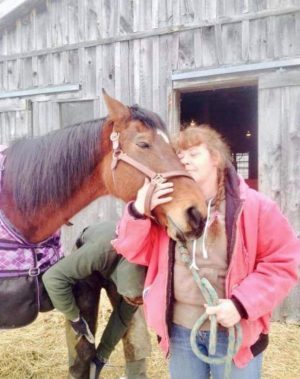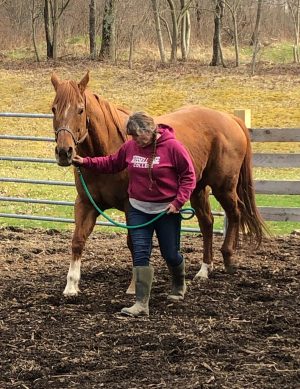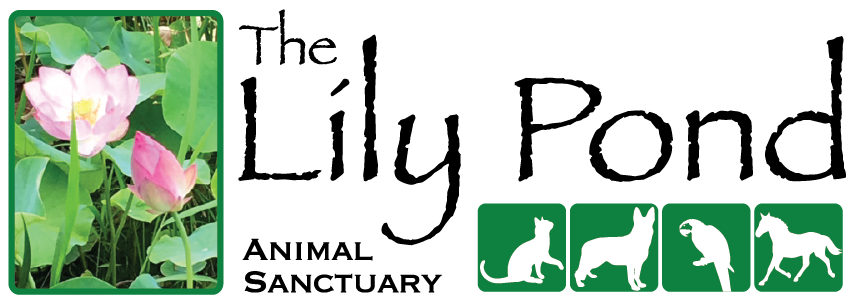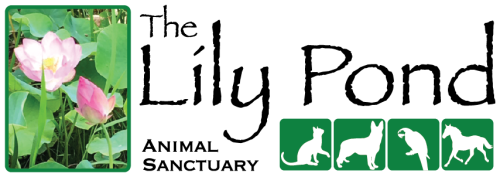An Interview with Barn Manager Brenda Izzo
Brenda Izzo has been caring for the horses and cats at The Lily Pond since 2018. Sanctuary Founder Susan Bandy interviewed her about how she came to work with horses and what she’s learned from her connection with them.

SB: Thank you for taking the time to share your thoughts on horse care. How did you get started working with horses?
BI: I grew up with horses. I received my first pony at age three. My father had gone to an auction to purchase Easter lilies for my mother and grandmother, but instead came home with a small Shetland pony in the back of his station wagon. He paid only $15.00 and I named him Sunny. Sunny was a great teacher, accommodating my lack of experience with gentleness. He always took care to avoid stepping on me when I fell off.
SB: Did you gain your experience with horses by growing up with them?
BI: No, my experience came much later in life. On December 13 of 2014, I was rescued by my first horse, a Thoroughbred named Pretty Girl. Yes, I said that correctly – I was rescued by her.
SB: Tell me about Pretty Girl.

BI: Earlier that year in May, I had lost my 24-year-old daughter Shauna to a senseless death. I was in denial for quite a while, and then became depressed as the holidays approached. Some pretty bad thoughts were going through my head because I believe that my first job as a parent was to protect my children, so I felt maybe the world would be better off without me. And then I got a call that a neighbor’s horse had escaped and was almost hit by a truck. I raced down the road and met the owner for the first time. I asked if I could help him catch her and he replied “No, in a couple days it won’t matter.” I should have left, but instead offered to help him fix her fence. He replied “Nope. In a couple days the dog food people are coming to get her.” I burst into tears and said to him, “Look, I lost my daughter to a senseless death. I’m not going to allow this horse to die a senseless death. I’ll pay you whatever you want for her.” He glanced at me and replied, “If you want her, you can take her. She’s yours.”
SB: So that’s when you adopted your first horse since your childhood pony Sunny?
BI: Well, I suddenly realized that I had a horse with no place to put her! What was I going to do? I called my daughter Morgan, who remembered meeting Lynn Cross, the founder of the sanctuary Little Brook Farm. Lynn had given a presentation at her school and advised the kids that “If you see something, say something.” We called Lynn, who knew exactly which horse we were talking about, as Lynn had been trying to rescue Pretty Girl for several years. Lynn promised to help us, and I also enlisted the support of my neighbor Mary Ellen, who had an empty horse barn. She used to admire Pretty Girl and agreed to let me house Pretty Girl temporarily in one of her stalls, as it was cold and snowing.
SB: Tell me about Pretty Girl’s homecoming.
BI: Morgan came with me and her dad followed in the car with the flashers on. It had been a long time since I had been around horses and I was a little nervous. The only thing I had to walk her home with was a dog leash. Morgan and I walked this 16-hand Thoroughbred the mile down the road to my place. About half way there, Pretty Girl stopped and looked straight up at the clouds. My daughter Shauna used to always run up behind me and throw her arms around my shoulders and say “I love you Mom!” At the moment Pretty Girl stopped, I could feel Shauna’s presence. I turned to my horse and asked, “Is my girl here? Do you see her? Because I can feel her.” Pretty Girl neighed, gave me a nod and we walked quietly together to her new home.

SB: Can you share more about your relationship with Pretty Girl?
BI: She saved my life. She refocused my direction; she helped me build self confidence and self esteem. And she put a smile back on Morgan’s face, which I hadn’t seen in a long time. We weren’t in a position financially to care for Pretty Girl at the time, so Lynn Cross suggested that I foster her, while Little Brook Farm supplied the hay and grain and farrier care until I could get back on my feet and formally adopt her.
SB: So Pretty Girl was also your primary teacher regarding horse care?
BI: Morgan and I wanted to do something to repay Lynn’s kindness, so we began volunteering at Little Brook Farm, caring for 16 of their horses twice a day, seven days a week for five years. The horses taught me a lot!
SB: What did the horses teach you?
BI: They taught me a lot about respect, healthy boundaries, and earning trust… things that I thought I had already known, but the horses taught me on a much deeper level. After Pretty Girl came into my life, I truly understood what it meant to have a heart connection with a horse. I was also involved in the rescue of several horses during my time volunteering at Little Brook Farm. That’s how I learned what to do with a horse in desperate need of love, care, and healing.
SB: What do you feel are the biggest challenges facing horses in the United States today?

BI: The slaughter has to stop. Horses are not raised as a food source – they have too many medications, such as fly spray and de-worming medications. Even though horse slaughter is now illegal in the United States, horses are being shipped across the borders to Canada and Mexico.
SB: The number of horses going to slaughter is high. Where are the majority of those horses coming from?
BI: Primarily overbreeding – by backyard breeders and the racing industries. Or by people who do not give them the proper training and consider them unmanageable. They even come from people who do not want to deal with their horse’s end of life, so they send them to auction where they are bought by the slaughterhouses. Everyone thinks that horses going to slaughter are old, sick and lame. But that’s not true! Many are young, sound horses.
SB: What are your thoughts on a solution to reducing the number of horses going to slaughter?
BI: Back in the day, people used to breed for quality, not quantity. So many Thoroughbreds and Standardbreds are overbred in the hope of having that one special champion who will win tons of money at the races. But what happen to the rest who don’t make it at the races? The solution is to reduce the overbreeding.
SB: What do you feel is the biggest challenge and greatest reward for people like you who work with horses, many of whom are rescued from sad situations?
BI: Winter is the biggest challenge; dealing with frozen water buckets, icy paddocks, and keeping the horses comfortable in extreme weather. My greatest reward — and there are so many — is when I’m working with a rescued horse who is broken; who doesn’t trust people because they’ve been let down by humans. Over time, you build that trust back up. It has to be earned and they make you work hard for it. But once you have the gift of a horse’s trust, it’s yours for life. That’s my greatest reward working with the horses.
SB: Would you share how you came to work at The Lily Pond sanctuary?
BI: Well, I was told about a weekend position at a new sanctuary that was just starting out with horses and needed help. I came to meet with you, and I remember you were so sick with the flu that weekend… so we decided that I’d start the next day! That has turned into a full time job managing the barn and cat house. I can honestly say that this is the first job I’ve ever had where I wake up earlier than I need to because I’m so excited to go to work and see all my friends. Whether they have hooves or paws, they always put a smile on my face.

SB: We’re so glad you are here! In closing, any advice you would like to share regarding how people can help horses even if they are not in a position to own one?
BI: Yes. I encourage people to call your local horse rescues and sanctuaries and offer to volunteer with feeding, grooming, and mucking stalls. This is a great way to connect with these majestic beings! If your schedule doesn’t permit volunteer time, most rescues and sanctuaries are grateful for donations — even just a $5 donation will treat a horse to lunch with the purchase of bale of hay. Do not underestimate the positive impact you can make in the life of a horse!
SB: Thank you Brenda. I am grateful for your time and for the excellent care that you provide to all the horses at The Lily Pond.


